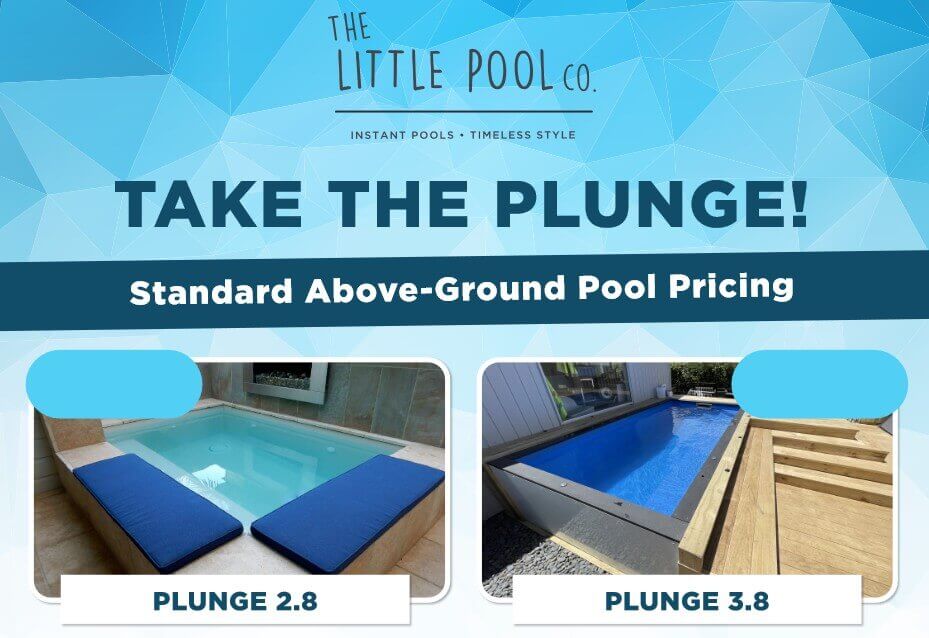When you are purchasing a swimming pool, one of the most important elements to take into account is the price. You will spend a lot of money on your pool, so you need to know it will provide good value and take care of all your swimming and relaxation needs.
If you are thinking of buying a backyard pool and want to know the kinds of figures you can expect to spend, read on – this guide offers everything you need to know about swimming pool prices, and the differences between the various types of pools on the market.
What are pool prices determined by?
Pool prices are influenced by a number of different factors, including:
- The size and shape of your pool
- The material it is built from
- Whether the pool is built inground or above ground
- Any optional extras you choose to add
- The size and shape of your backyard
- How easily your site can be reached
More circumstances may also apply to your own backyard and choice of pool. This is why it is impossible to give definitive answers about swimming pool prices, as all pools have to be different to suit the needs and preferences of the owner. However, the factors listed here are the main considerations to take into account when working out the budget for your pool.
1. The size and shape of your pool
As you would probably expect, larger pools tend to cost more than smaller ones. This is because there is more work involved in excavating the ground, and more effort needed during the actual installation. In addition, more materials have been used in building the pool itself.
However, in the case of prefabricated pools, size does not always make a huge difference. There is a very similar amount of work in installing a medium-sized pool and a large one, so they do not tend to differ from each other in price as much as you might think.
If you are looking for a pool which is a particularly unusual shape, this is likely to have a bigger impact than the size of your pool when it comes to pool prices. If you can’t find a prefabricated pool which suits your design ideas, the only other option is to have a concrete pool built from scratch, which will cost a considerable amount.
2. The material your pool is built from

There are three main materials which Australian swimming pools are built from, and the material you choose will have an impact on the price tag of your pool.
Concrete is the most expensive material. This is because concrete pools cannot be prefabricated, they have to be built from scratch in your backyard. This involves a considerable amount of work, taking weeks or possibly even months depending on the size and design of your pool, so the labour costs are high. In addition, a concrete pool has to be tiled or pebbled before it can be used, which also adds to the cost. However, concrete pools are strong and durable, and have stood the test of time, so a concrete pool is a worthwhile investment if you cannot find a prefabricated pool to suit your needs.
Fibreglass pools are the mid-range choice when it comes to price. They are cheaper than concrete pools as the pool shells are pre-made in factories, so they can be delivered to your site rather than having to be built from scratch. This brings the cost down considerably. Fibreglass pools also have a number of other advantages – they do not need to be tiled or pebbled, and they are easier to keep clean than concrete pools as they do not have porous surfaces, so they are resistant to algae and bacteria. Additionally, fibreglass pools are as strong and durable as concrete, especially those with ceramic cores, which have been shown to be capable of withstanding earthquakes.
Vinyl-liner pools are the cheapest option, which makes them attractive if you are on a budget. However, they are sometimes not as cost-effective as they initially appear. The vinyl linings are quite delicate, so they can easily be damaged, even with normal pool use. This means repair bills can quickly add up. You also have to factor in the cost of replacing the lining completely every five to seven years.
3. Whether the pool is built inground or above ground
The way your pool will be installed is an important consideration when planning your swimming pool budget. Inground pool prices are significantly higher than the cost of above ground pools. This is because there is far more work involved in installing a pool inground, as your backyard has to be excavated before any work can begin. The planning is all-important, as the positioning has to be exactly right if you want your pool to look great from all angles while still enabling you to make the best use of the rest of the space in your backyard. Then the installation itself is likely to take several days if you choose a prefabricated pool, or weeks, possibly even months, if you are having a concrete pool built from scratch.
Above ground pool prices are lower because there is no excavation or building work involved. Most above ground pools are prefabricated fibreglass or vinyl-liner pools, or specialist solutions such as shipping container pools or Little Pools. Many above ground pools are sold as complete kits, including their own lighting and filtration systems, so this also saves on cost. However, the main advantage of above ground pools is that they can be installed and used almost instantly. All they need is a concrete pad installed in your backyard to give the pool a level base to sit on, and a connection to an electrical supply before the pool can be filled and used. This means you have a pool which is budget-friendly and can be enjoyed straight away.
4. Any optional extras you choose to add

Your pool has to cater to your usage needs and also reflect your personal tastes. In order to achieve this, you might want to add some optional extras, which you will also need to factor into your budget.
If you are having an inground pool built rather than buying a complete above ground kit, your choice of filtration system will have an impact on the price, as will the lighting you choose. Some tiling or pool colour options are likely to be more costly than others.
You may also want to add a water feature to make your pool more attractive and assist with making your pool a more relaxing experience. Or for the ultimate touch of luxury, you could choose an infinity pool with a disappearing edge. These things will add significantly to the overall cost, due to the extra work involved in creating these features.
Even if you have chosen a complete above ground pool, there are elements which will affect the price. For example, you might choose to purchase additional lighting or select an exterior cladding option which does not come as part of the package. However, above ground pool prices are still significantly cheaper, even when you take these things into account.
5. The size and shape of your backyard
If your backyard is a particularly unusual shape with awkward angles, or it has a significant slope, you might find yourself having to pay more for your pool. While there is now a huge range of prefabricated pools to choose from, depending on the shape of your backyard, it is possible that there are none available which will fit into the space. If this is the case, the only option is to have a concrete pool built from scratch, as this can be moulded into virtually any shape to fit the layout of your backyard.
If you have a sloping site, you might have to have your pool built partially above ground and partially inground in order for it to be level. This is possible to achieve with a fibreglass pool, but it does rule out above ground pool solutions, so you should be prepared to pay more to have your swimming pool installed.
6. Ease of access to the site
This is really only a concern if you have an inground pool built, as the builders will need access to your backyard every day, and will have to bring in a wide range of tools and equipment. If access to the site is particularly difficult, a builder may charge extra for the increased inconvenience. This is why people who are having a new home built from scratch will often choose to have their pool built at the same time, as this makes access easier.
Most above ground pools can be delivered directly to your home on a truck, so there is no real need to worry about access as long as all your measurements have been worked out correctly. The other main advantage of these pools is that they can easily be taken with you if you ever move home, as they are so easy to transport and install.
So, what is the average swimming pool price?

As you can see, there are so many factors to take into account that it is virtually impossible to provide an accurate figure for each case. However, average costs are as follows:
An inground concrete pool usually costs between $55,000 and $75,000, although depending on what options you choose, you could end up spending $100,000 or even more.
A fibreglass pool installed inground is likely to cost you between $35,000 and $55,000. Some models can start from as little as $15,000, but it is essential to check the build quality of these before going ahead.
Vinyl-liner pools start from around $10,000. However, you do have to factor in maintenance costs; and if you want a vinyl-liner pool installed inground, the cost will rise to around $25,000.
Shipping container pools cost on average between $20,000 and $30,000. This is a relatively new and extremely fashionable market, so it is possible to find container pools for as little as $10,000, but these are unlikely to be of good quality, so it is essential to do your research here.
Little Pools start from $28,000, so they are comparable to shipping container pools while offering the technology and build quality of a leading fibreglass pool. These are ideal solutions for those who are looking for the convenience of a transportable above ground pool, but expect it to last for many years to come.
Find out more about pool prices
If you would like more information about Little Pools and how we compare to other pool manufacturers in terms of price, please contact us. Our team will be happy to help.








